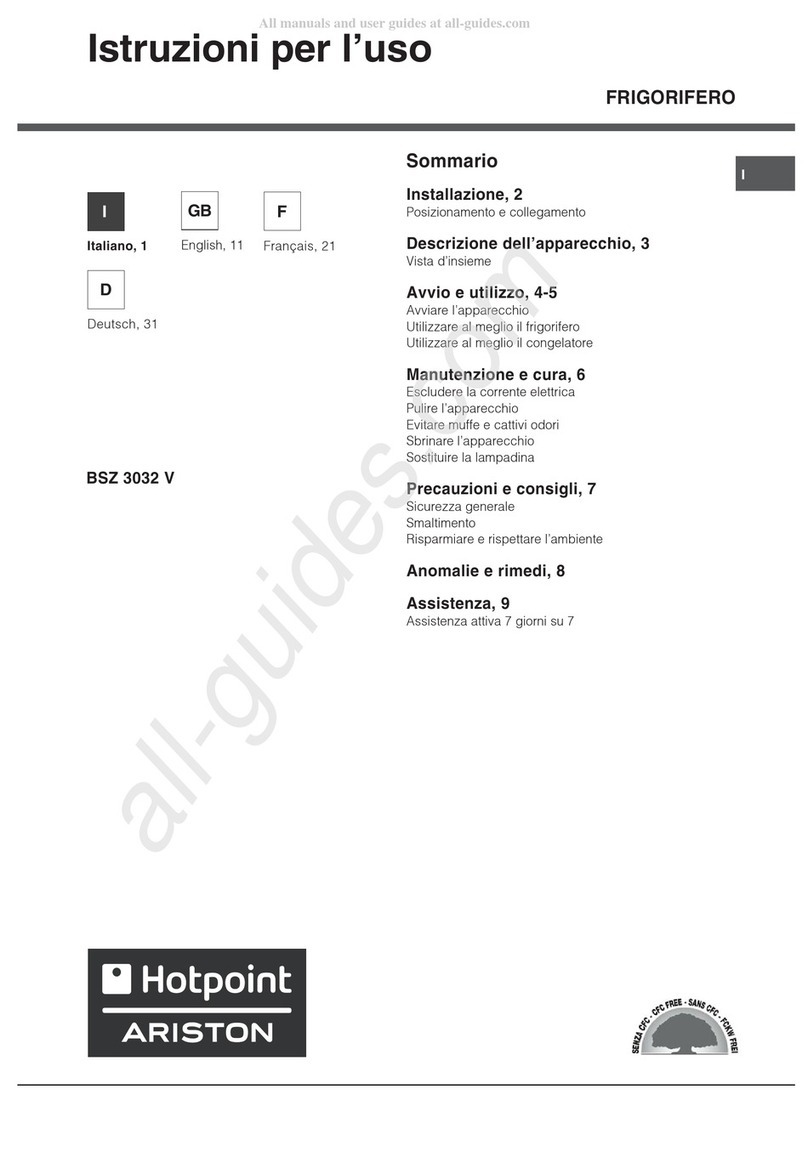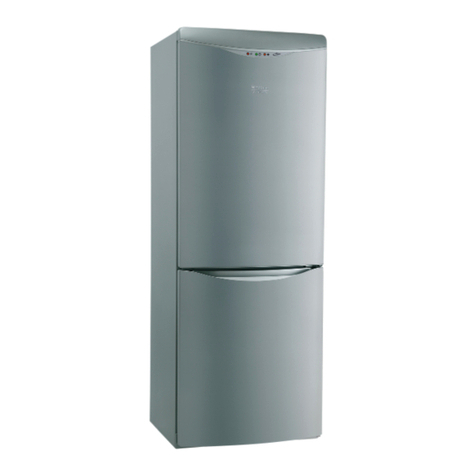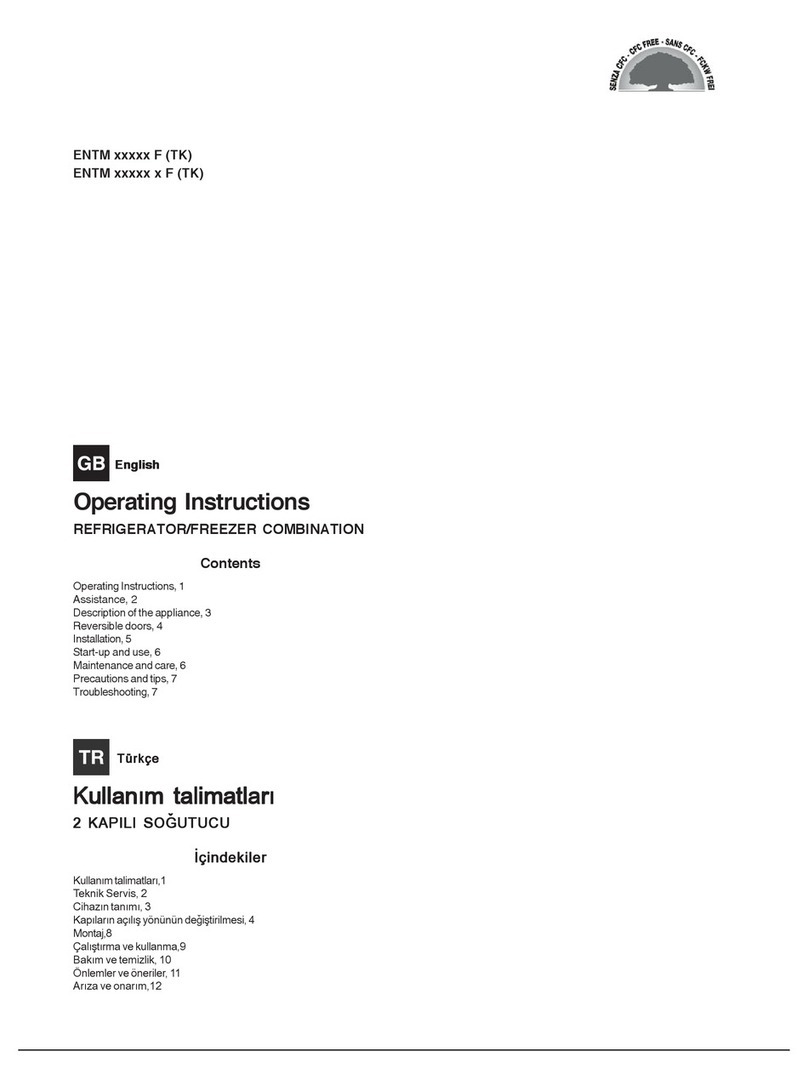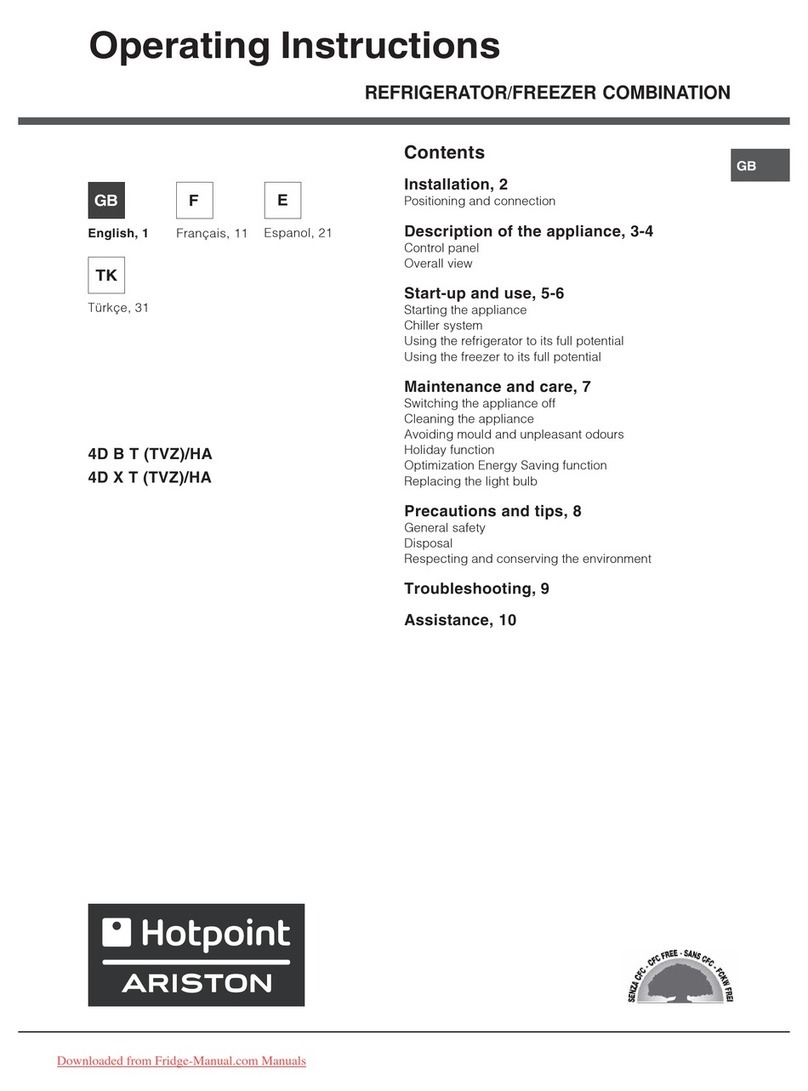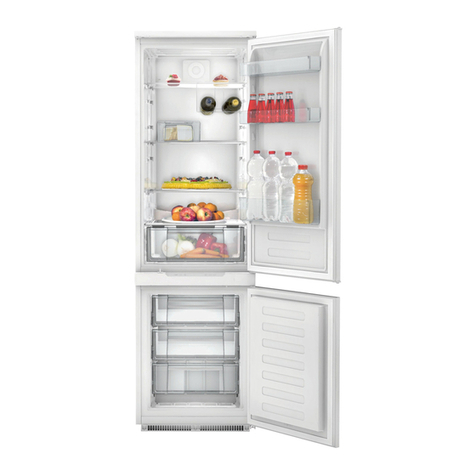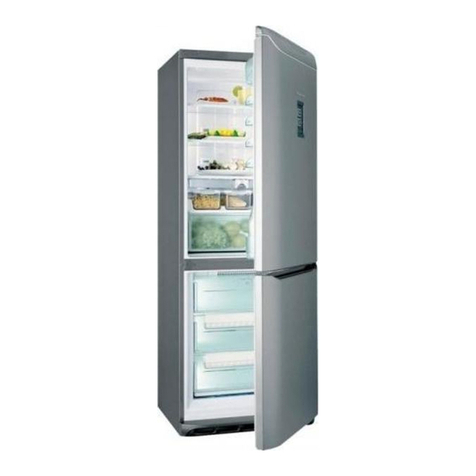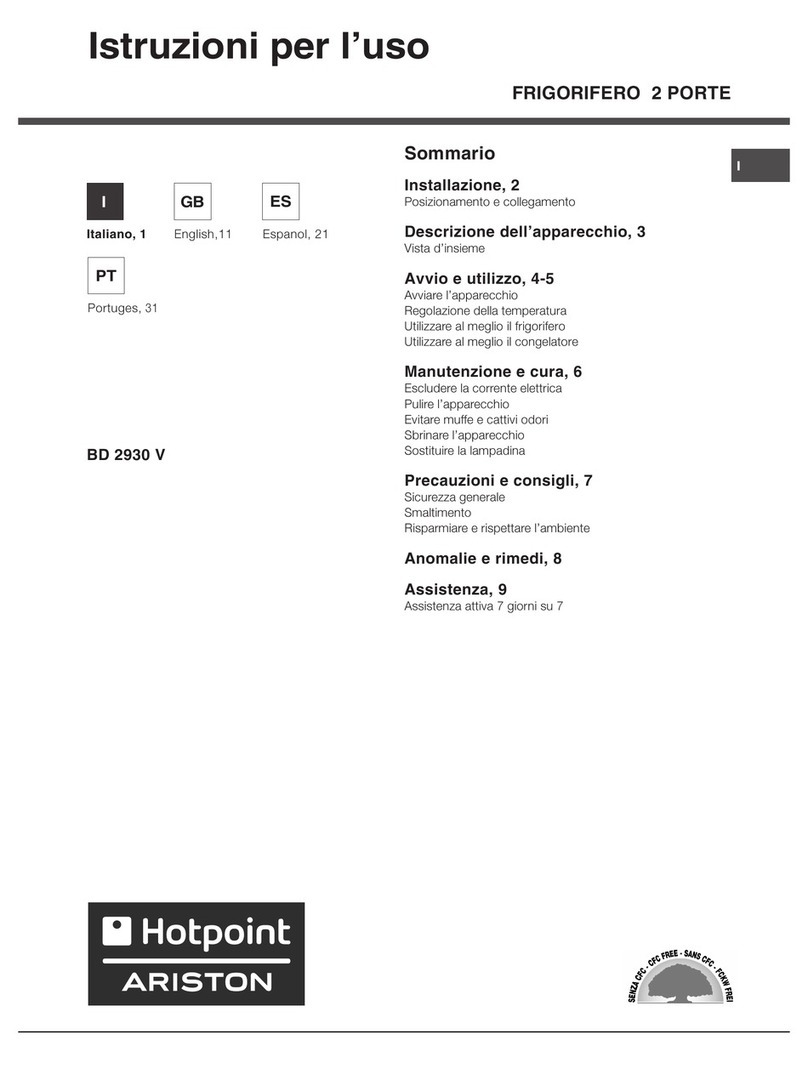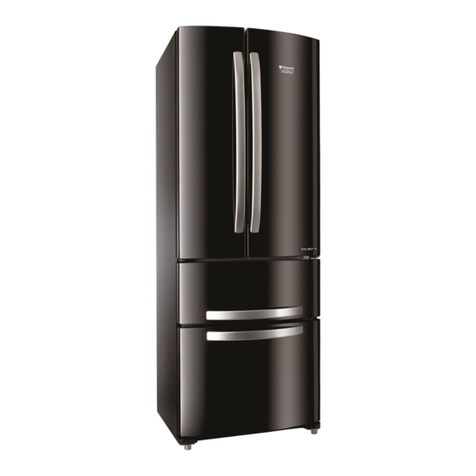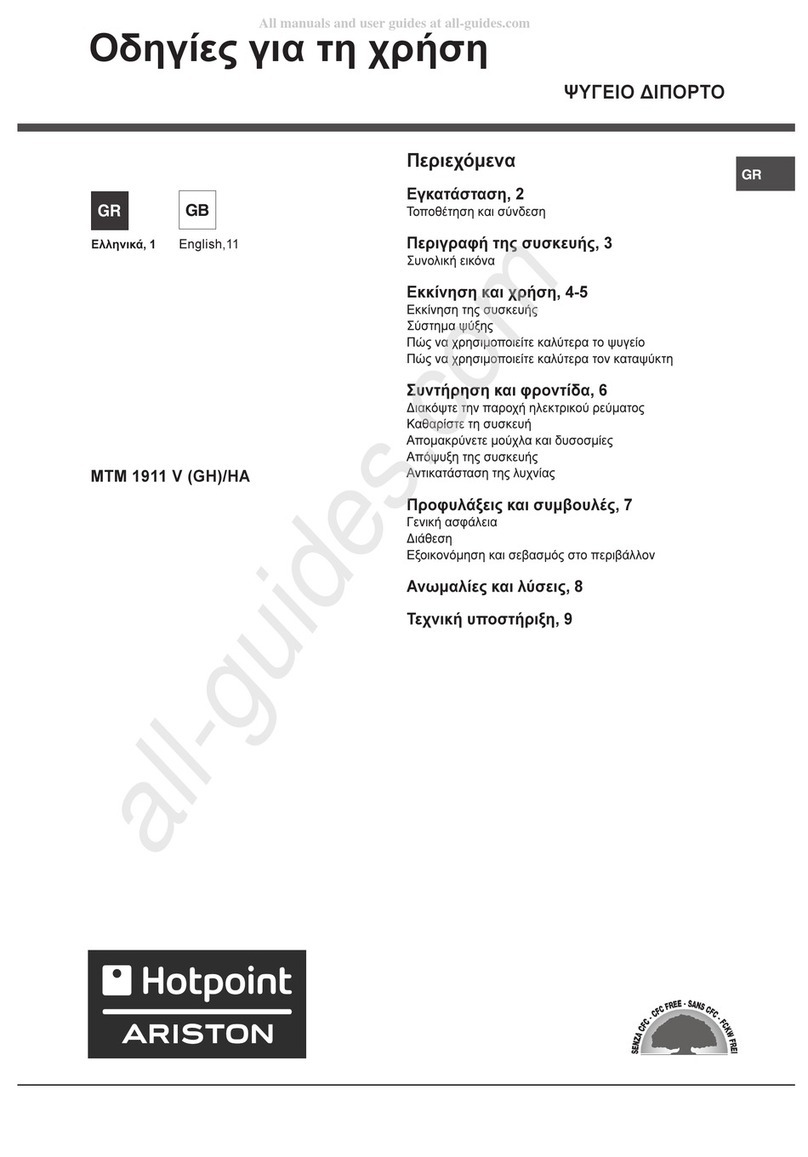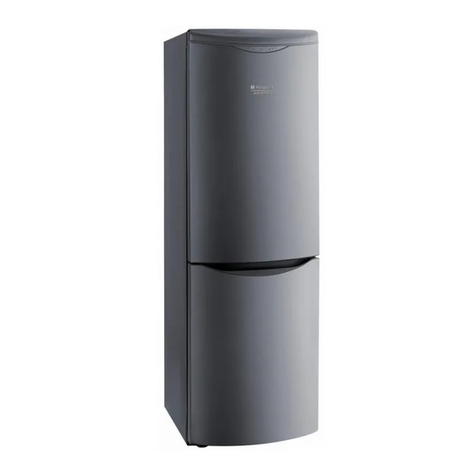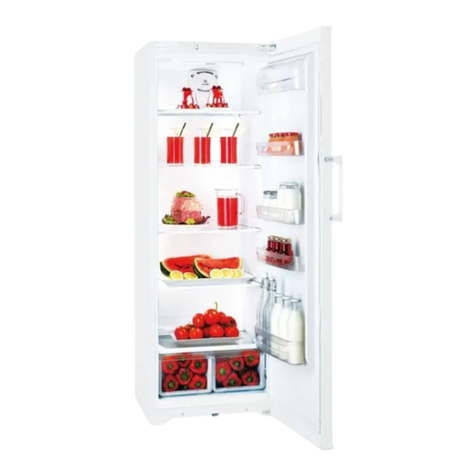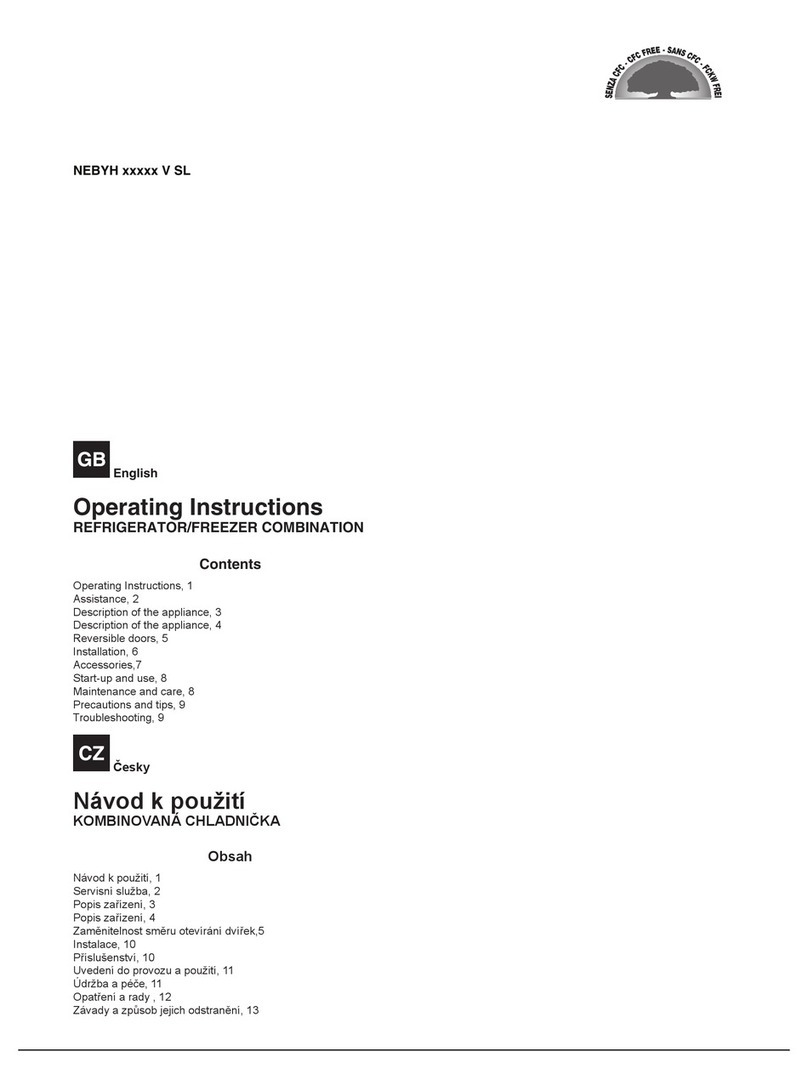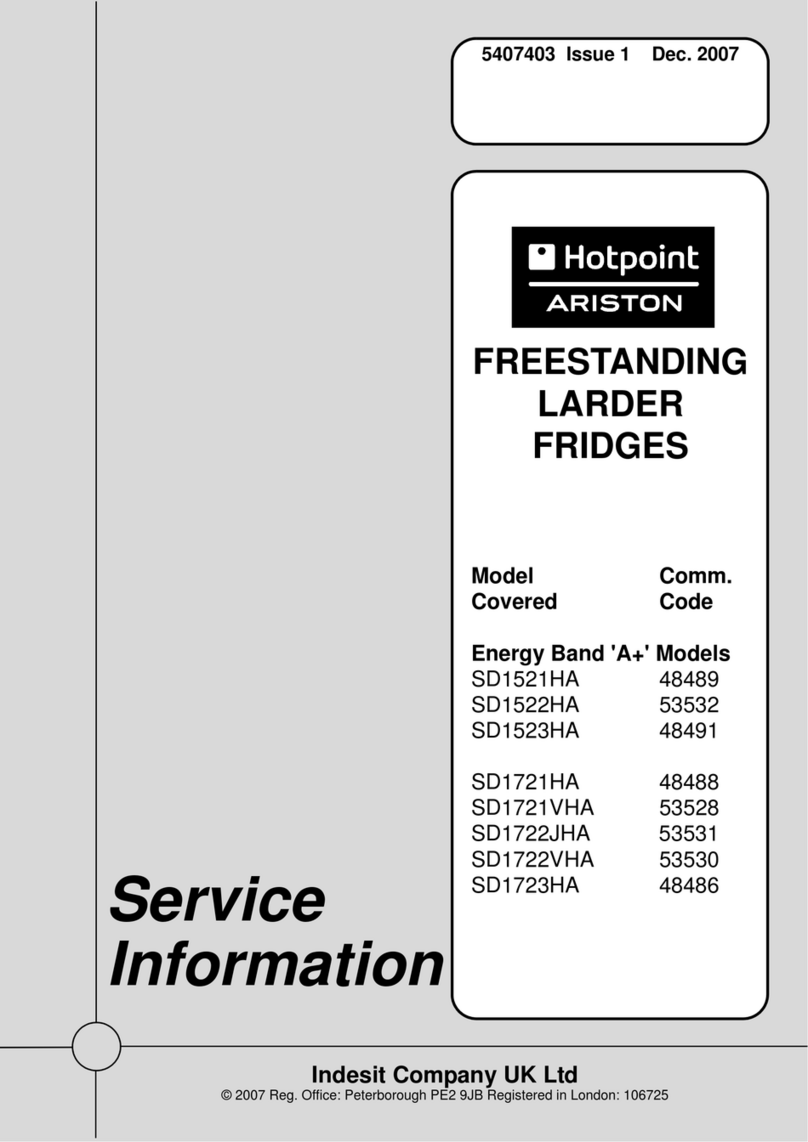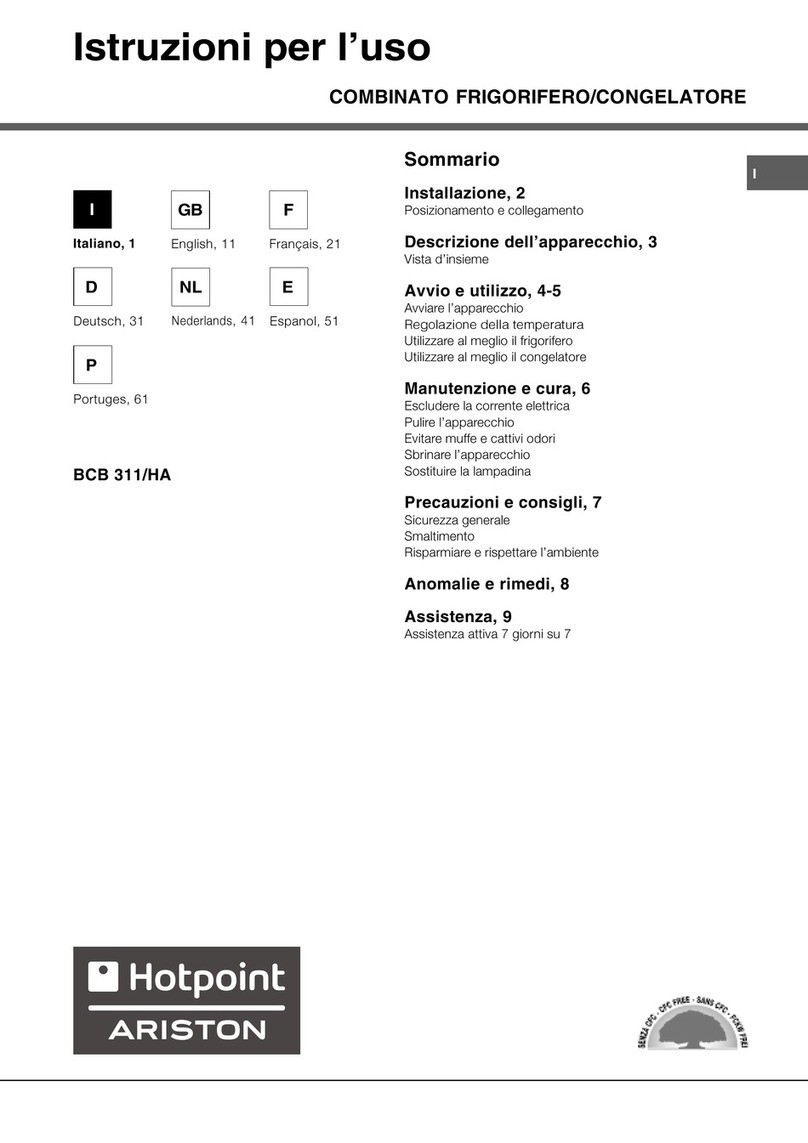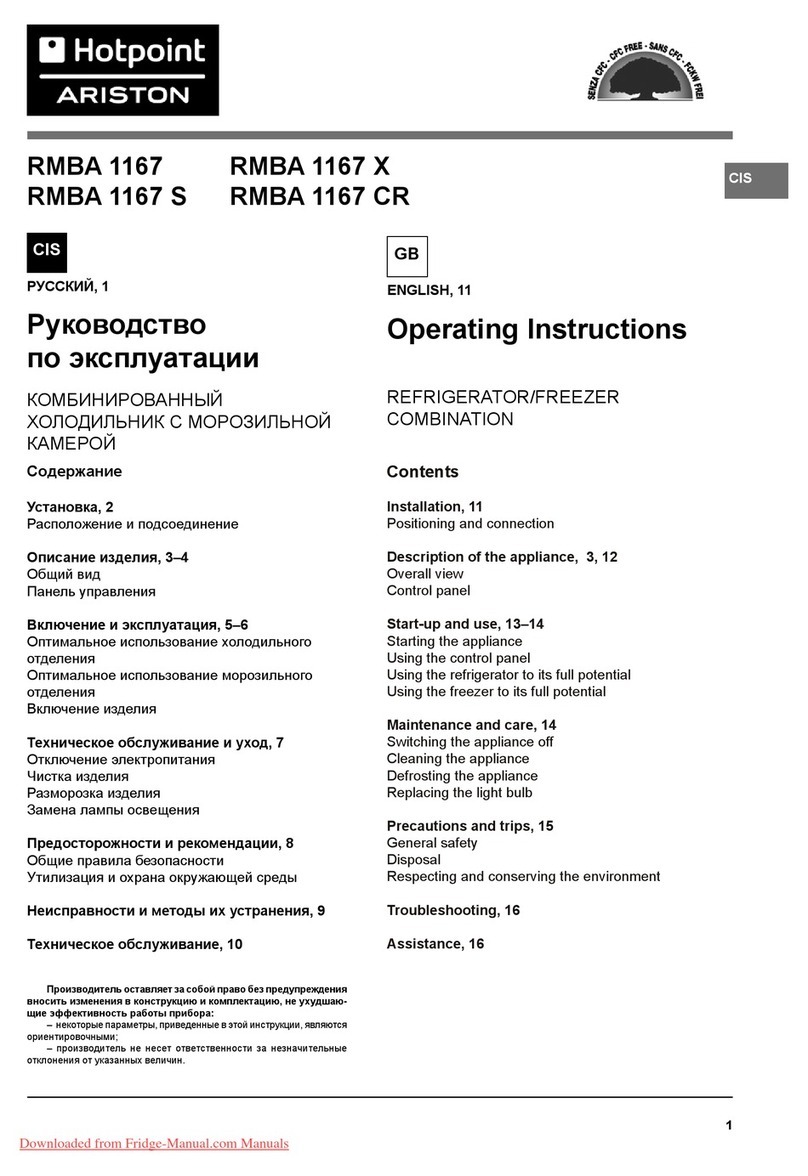GR
7
ÐñïöõëÜîåéò êáé óõìâïõëÝò
! Ç óõóêåõÞ ó÷åäéÜóôçêå êáé êáôáóêåõÜóôçêå
óýìöùíá ìå ôïõò äéåèíåßò êáíüíåò áóöÜëåéáò. Ïé
ðñïåéäïðïéÞóåéò áõôÝò ðáñÝ÷ïíôáé éá ëü ïõò
áóöáëåßáò êáé ðñÝðåé íá äéáâáóôïýí ðñïóåêôéêÜ.
Ç óõóêåõÞ áõôÞ åßíáé óýìöùíç ìå ôéò
áêüëïõèåò ÊïéíïôéêÝò Ïäç ßåò:
- 73/23/CEE ôçò 19/02/73 (×áìçëÞ ÔÜóç) êáé
ìåôá åíÝóôåñåò ôñïðïðïéÞóåéò.
- 89/336/CEE ôçò 03/05/89 (Çëåêôñïìá íçôéêÞ
Óõìâáôüôçôá) êáé ìåôá åíÝóôåñåò
ôñïðïðïéÞóåéò.
- 2002/96/CE..
ÃåíéêÞ áóöÜëåéá
Ç óõóêåõÞ ó÷åäéÜóôçêå éá ìç åðá åëìáôéêÞ ÷ñÞóç óôï
åóùôåñéêü êáôïéêßáò.
Ç óõóêåõÞ ðñÝðåé íá ÷ñçóéìïðïéåßôáé éá ôç óõíôÞñçóç
êáé êáôÜøõîç ôñïößìùí, ìüíï áðü åíÞëéêá Üôïìá êáé
óýìöùíá ìå ôéò ïäç ßåò ðïõ áíáöÝñïíôáé óôï ðáñüí
å ÷åéñßäéï.
Ç óõóêåõÞ äåí å êáèßóôáôáé óå åîùôåñéêü ÷þñï, áêüìç êé
áí ï ÷þñïò óêåðÜæåôáé, éáôß åßíáé ðïëý åðéêßíäõíï íá
ôçí áöÞíåôå åêôåèåéìÝíç óôç âñï÷Þ êáé óôçí êáêïêáéñßá.
Ìçí á ßæåôå ôç óõóêåõÞ ìå õìíÜ ðüäéá Þ ìå ôá ÷Ýñéá Þ
ôá ðüäéá âñå ìÝíá.
Ìçí á ßæåôå ôá åóùôåñéêÜ øõêôéêÜ ìÝñç: õðÜñ÷åé
êßíäõíïò å êáýìáôïò Þ ôñáõìáôéóìïý.
Ìç â Üæåôå ôï âýóìá áðü ôï ñåýìá ôñáâþíôáò ôï
êáëþäéï, áëëÜ ðéÜíïíôáò ôï âýóìá.
Ðñéí áðü ïðïéáäÞðïôå åíÝñ åéá êáèáñéóìïý êáé
óõíôÞñçóçò åßíáé áíá êáßï íá â Üæåôå ôï âýóìá áðü ôçí
ðñßæá. Äåí áñêåß íá öÝñåôå ôïí åðéëï Ýá éá ÔÇ
ÑÕÈÌÉÓÇ ÔÇÓ ÈÅÑÌÏÊÑÁÓÉÁÓ óôç èÝóç (óõóêåõÞ
óâçóôÞ) éá åîïõäåôÝñùóç êÜèå çëåêôñéêÞò åðáöÞò.
Óå ðåñßðôùóç âëÜâçò, óå êáìßá ðåñßðôùóç ìçí
åðåìâáßíåôå óôïõò åóùôåñéêïýò ìç÷áíéóìïýò éá
åðéóêåõÞ.
Ìç ÷ñçóéìïðïéåßôå óôï åóùôåñéêü ôùí
äéáìåñéóìÜôùí óõíôÞñçóçò êáôåøõ ìÝíùí
ôñïößìùí, åñ áëåßá êïöôåñÜ êáé áé÷ìçñÜ Þ
çëåêôñéêÝò óõóêåõÝò áí áõôÝò äåí åßíáé ôïõ ôýðïõ
ðïõ å êñßíåé ï êáôáóêåõáóôÞò
.
Ìç âÜæåôå óôï óôüìá êýâïõò ðïõ ìüëéò â Üëáôå áðü ôïí
êáôáøýêôç.
Ìçí åðéôñÝðåôå óå ðáéäéÜ íá ðáßæïõí ìå ôç óõóêåõÞ. Óå
êáìßá ðåñßðôùóç äåí ðñÝðåé íá êÜèïíôáé óôéò èÞêåò Þ íá
êñÝìïíôáé óôçí ðüñôá.
Ïé óõóêåõáóßåò äåí åßíáé ðáé÷íßäéá éá ðáéäéÜ.
ÄéÜèåóç
ÄéÜèåóç ôïõ õëéêïý óõóêåõáóßáò: íá ôçñåßôå ôïõò
ôïðéêïýò êáíüíåò, Ýôóé ïé óõóêåõáóßåò èá ìðïñïýí
áí åðáíá÷ñçóéìïðïéçèïýí.
Ç åõñùðáúêÞ ïäç ßá 2002/96/EK éá ôá Áðüâëçôá
Çëåêôñéêïý êáé Çëåêôñïíéêïý Åîïðëéóìïý (ÁÇÇÅ),
áðáéôåß üôé ïé ðáëáéÝò ïéêéáêÝò çëåêôñéêÝò óõóêåõÝò
äåí ðñÝðåé íá áðïâÜëïíôáé ìáæß ìå ôá õðüëïéðá
áðüâëçôá ôïõ äçìïôéêïý äéêôýïõ. Ïé ðáëáéÝò
óõóêåõÝò ðñÝðåé íá óõëëå÷èïýí ÷ùñéóôÜ
ðñïêåéìÝíïõ íá âåëôéóôïðïéçèïýí ç áðïêáôÜóôáóç
êáé ç áíáêýêëùóç ôùí õëéêþí ðïõ ðåñéÝ÷ïõí êáé ìå
óêïðü ôç ìåßùóç ôùí âëáâåñþí åðéðôþóåùí óôçí
áíèñþðéíç õ åßá êáé ôï ðåñéâÜëëïí. Ôï óýìâïëï ìå
ôï äéå ñáììÝíï äï÷åßï áðïâëÞôùí óôï ðñïúüí
õðåíèõìßæåé óå óáò ôçí õðï÷ñÝùóÞ óáò, ðùò üôáí
åðéèõìåßôå íá ðåôÜîåôå ôç óõóêåõÞ ,ðñÝðåé íá
óõëëå÷èåß ÷ùñéóôÜ.
Ïé êáôáíáëùôÝò èá ðñÝðåé íá áðåõèýíïíôáé óôéò
ôïðéêÝò áñ÷Ýò Þ óôá êáôáóôÞìáôá ëéáíéêÞò éá
ðëçñïöïñßåò ðïõ áöïñïýí ôç óùóôÞ äéÜèåóç ôùí
ðáëáéþí çëåêôñéêþí óõóêåõþí.
Å ïéêïíüìçóç êáé óåâáóìüò óôï
ðåñéâÜëëïí
Å êáôáóôÞóôå ôç óõóêåõÞ óå äñïóåñü êáé êáëÜ
áåñéæüìåíï ðåñéâÜëëïí, ðñïóôáôåýóôå ôç áðü ôçí
Üìåóç Ýêèåóç óôéò çëéáêÝò áêôßíåò, ìç ôçí
ôïðïèåôåßôå ðëçóßïí ðç þí èåñìüôçôáò.
Ãéá íá åéóÜ åôå Þ íá åîÜ åôå ôá ôñüöéìá, áíïß åôå ôéò
ðüñôåò ôçò óõóêåõÞò éá üóï ìéêñüôåñï äéÜóôçìá
ßíåôáé.
ÊÜèå Üíïé ìá ôùí èõñþí ðñïîåíåß óçìáíôéêÞ
êáôáíÜëùóç åíÝñ åéáò.
Ìç åìßæåôå ìå ðïëëÜ ôñüöéìá ôç óõóêåõÞ: éá
êáëýôåñç óõíôÞñçóç, ôï øý÷ïò ðñÝðåé íá
êõêëïöïñåß åëåýèåñá. Áí ðáñåìðïäéóôåß ç
êõêëïöïñßá, ï óõìðéåóôÞò èá äïõëåýåé óõíå÷þò.
Ìçí åéóÜ åôå æåóôÜ ôñüöéìá: èá áíÝâáæáí ôçí
åóùôåñéêÞ èåñìïêñáóßá áíá êÜæïíôáò ôï óõìðéåóôÞ
óå õðåñâïëéêü öüñôï åñ áóßáò, ìå õðåñâïëéêÞ
êáôáíÜëùóç çëåêôñéêÞò åíÝñ åéáò.
Áðïøýîôå ôç óõóêåõÞ áí ó÷çìáôéóôåß ðÜ ïò (âëÝðå
ÓõíôÞñçóç). ¸íá ðá÷ý óôñþìá ðÜ ïõ êáèéóôÜ
äõóêïëüôåñç ôçí åê÷þñçóç ôïõ øý÷ïõò óôá ôñüöéìá
êáé áõîÜíåôáé ç êáôáíÜëùóç åíÝñ åéáò.
Äéáôçñåßôå áðïôåëåóìáôéêÜ êáé êáèáñÜ ôá
ðåñéâëÞìáôá, Ýôóé ðïõ íá åöáñìüæïõí êáëÜ óôéò
ðüñôåò êáé íá ìçí áöÞíïõí ôï øý÷ïò íá åîÝëèåé
(âëÝðå ÓõíôÞñçóç).


